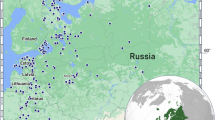Abstract
Relying on several decades of research experience, ever more new methods and methodological approaches, the opportunities of the application of palynological analysis for shallow lake sediments are summarised. New findings — not yet appeared in international publications — are also mentioned and illustrated. Further tasks of research are outlined.
Similar content being viewed by others
References
Andersen, S. Th.: Vegetation and the environment in Denmark in the Early Weichselian Glacial. Geol. Survey of Denmark II Series 75, 1–175 (1961)
Cserny, T.: Results of actuogeological research into Lake Balaton. Annual Report of the Hungarian State Geological Institute (MÁFI) for 1985. 343–365 (1987) (in Hungarian with English summary)
Cserny, T.; Corrada, R.: Results of the detailed geophysical-geological investigations of Lake Balaton. Annual Report of MÁFI for 1987. 341–347 (1989) (in Hungarian with English summary)
Gábori-Csánk, V.: La détermination de l'age absolu de la Station de Ságvár. Archeológiai értesíto 87, 125–129 (1960)
Györffy, Gy.; Zólyomi, B.: The face of the Carpathian Basin and the Etelköz before a millennium. 13–37. In: Kovács, L. (ed.), The Magyar Conquest and Archeology. 1994. (in Hungarian)
Járai-Komlódi, M.: The Late Glacial and Holocene flora of the Hungarian Great Plain. Ann. Univ. Sci. Budapest. Sectio Biol. 9–10, 199–225 (1968)
Járai-Komlódi, M.: Some problems of Pleistocene chronology and the Plio-Pleistocene boundary. Botanikai Közlemények 58, 131–143 (1971) (in Hungarian)
Járai-Komlódi, M.: Postglacial climate and vegetation history in Hungary. pp. 37–47. In: Pécsi, M.; Kordos, L. (eds.), Holocene environment in Hungary. Contribution of the INQUA Hungarian National Committee to the XIIth INQUA Congress. Ottawa, Canada, 1987. Geogr. Res. Inst. Hungarian Academy of Sciences, Budapest 1987.
Marosi, S.: Geomorphological investigations of the Balaton Basin and their results. pp. 41–52. In: Bíró, P. (ed.), Balaton research is hundred years old. pp. 41–52. 33rd Hydrobiological Days, 1991. Tihany 1992. (in Hungarian)
Marosi, S.; Szilárd, J.: Neuere Angaben über das Alter des Balatons. Földrajzi Értesíto 23, 333–346 (1974) (in Hungarian with German summary)
Marosi, S.; Szilárd J.: The origin of Lake Balaton. Földrajzi Közlemények 29, (105,) 1–30 (1981) (in Hungarian with English summary)
Miháltz-Faragó, M.: Palynological examination of bottom samples from Lake Balaton. Annual Report of MÁFI for 1981. Budapest 439–448 (1982)
Nagy, E.: Palynological analysis of the Upper Pannonian brown coal of the Mátra foothills. Ann. Inst. Geol. Publ. 12(1), 24–352 (1958) (in Hungarian with English summary)
Nagy, E.: The sporomorpha of the Hungarian Neogene. Geol. Hung. 47, pp. 1- 471. 1985.(in Hungarian with summary)
Nagy-Bodor, E.: Palynological study of Pannonian and Holocene deposits from Lake Balaton. Annual Report of MÁFI for 1986. 535–568 (1988) (in Hungarian with English summary)
Pécsi, M.: Lithostratigraphical subdivision of the loess sequences in Hungary. Földrajzi Közlemények 23, (99) 217–230 (1975) (in Hungarian with English summary)
Pécsi, M.: Chronostratigraphy of Hungarian loesses and the underlying subaerial formation. pp. 33–49. In: Pécsi, M. (ed.), Loess and the Quaternary. Akadémiai Kiadó, Budapest 1985.
Pécsi, M. (ed.): National Atlas of Hungary. Cartographia, Budapest 1989.
Rónai, A.: The geology of Lake Balaton and surroundings. Mitt. Internat. Verein Limnol. 17, 275–281 (1969)
Stieber, J.: Anthracotomy, Quaternary chronology and Pleistocene vegetation in Hungary. Manuscript, 399 p. Budapest 1957. (in Hungarian)
Zólyomi, B.: Die Entwicklungsgeschichte der Vegetation Ungarns seit dem letzten Interglazial. Acta Biol. Acad. Sci. Hung. 4, 367–430 (1953)
Zólyomi, B.: Landwirtschaftliche Kultur und Wandlung der Vegetation im Holozän am Balaton. Phytocoenologia 7, 121–126 (1980)
Zólyomi, B.: Degree and rate of sedimentation in Lake Balaton. pp. 57–79. In: Pécsi, M. (ed.), Pleistocene Environment in Hungary. Contribution of the INQUA Hungarian National Committee to the XIIth INQUA Congress, Ottawa, Canada. Geogr. Res. Inst. Hungarian Academy of Sciences, Budapest 1987.
Zólyomi, B.; Précsényi, I.: Pollenstatistische Analyse der Teichablagerungen des mittelalterlichen Klosters bei Pilisszentkereszt. Vergleich mit dem Grundprofil des Balaton. Acta Archaeol. Acad. Sci. Hung. 37, 153–158 (1985)
Zólyomi, B.; Nagy, E.: The past of Lake Balaton in the light of pollen stratigraphical research. pp. 23–31. In: Bíró. P. (ed.), Balaton research is hundred years old. 33rd Hydrobiological Days, 1991. Tihany 1992.
Author information
Authors and Affiliations
Rights and permissions
About this article
Cite this article
Zólyomi, B. Opportunities for pollen stratigraphic analysis of shallow lake sediments: the example of Lake Balaton. GeoJournal 36, 237–241 (1995). https://doi.org/10.1007/BF00813177
Issue Date:
DOI: https://doi.org/10.1007/BF00813177




